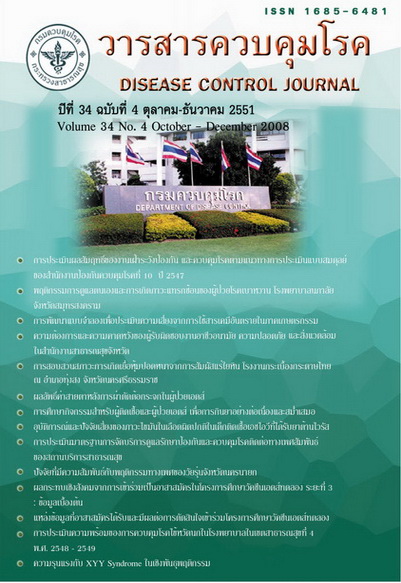Self-care Behaviors and Complications of Diabetes Mellitus Patients in Napalai Hospital, Samutsongkhram Province
Keywords:
Diabetes Mellitus patients, self care behavior, Napalai HospitalAbstract
The objectives of this cross-sectional study were to examine the knowledge of diabetes mellitus, as regard to self-care behavior, factors related to self-care behavior, and complication in diabetes mellitus patients in Napalai hospital (which is government hospital in Samutsongkhram Province : 90 beds, general treatment). Sample group was taken by accidental sampling, of which a total of 260 diabetes mellitus patients who were equal or over 15 years old and have had medical treatment at Napalai hospital for over 3 months. Questionnaire was employed as instrument for data collecting during November 2006 – January 2007. Data was analyzed by descriptive statistics and multiple regression analysis. Studied results indicated that the majority, 83.5 percent, had high level of knowledge of diabetes mellitus and 70.8 percent had moderate level of self-care behavior, 28.8 and 0.4 percent were at low and high level, respectively. Uncorrected self-care behaviors which mostly found in both male and female included, periodic ophthalmic examination by ophthalmologist at least once a year, extremity foot exercising, and also physical exercising. Male had more uncorrected behavior than female regarding drinking and smoking, even though this is seldom behaved. Factors related to self-care behavior by statistical significance (P-value <0.05) in female, included knowledge of diabetes mellitus, acquired information and duration of the illness but the factor in male is only the duration of the illness. These relationships, both in female and male, were positively related. In regard to the complication, there were 68.5 percent of which 69.5 percent found in female and 65.8 percent found in male. Complications in female mostly included, diabetic hypertension (32.6 percent) and diabetic retinopathy, cardiovascular, neuropathy, nephropathy, and complexion complication were 11.8, 9.1, 4.3, 0.5, and 0.5 percent, respectively, while multiple complications in female was 10.7 percent. Complications in male included, diabetic hypertension, 21.9 percent, diabetic cardiovascular, retinopathy, neuropathy, and nephropathy complication accounted to 12.3, 9.6, 8.2, and 2.7 percent, respectively, while multiple complications in male was 11.0 percent. According to the results, there should be developing program for diabetes mellitus patients to change toward corrected self-care behavior, in order to control illness in appropriate condition and prevent consequent serious complications.
Downloads
References
2. อัญชลี ศิริพิทยาคุณกิจ. สถานการณ์โรคเบาหวานในประเทศไทย. (online) Available URL : http://epid. Moph.go.th /weekly/w_2548/Weekly48_homepge/wk48_47/wk48_47_3.html .2551. (วันที่ค้นข้อมูล : 15 มิถุนายน 2551).
3. เสรี หงส์หยก. เด็กไทยอายุสั้น 3 ขวบก็เป็นเบาหวานแล้ว. (online) Available URL : http://www. raklukefamilygroup. com/news.php?cat_id=1&id=2343. 2551. (วันที่ค้นข้อมูล : 15 มิถุนายน 2551).
4. สำนักงานสาธารณสุขจังหวัดสมุทรสงคราม. สถิติสาธารณสุขจังหวัดสมุทรสงคราม ปี 2548. สมุทรปราการ : โรงพิมพ์สตาร์บลูม. 2548.
5. งานคลินิกโรคเบาหวาน โรงพยาบาลนภาลัย. จำนวนผู้ป่วยโรคเบาหวาน โรงพยาบาลนภาลัย. 2548 :1.เอกสารอัดสำเนา.
6. พวงรัตน์ ทวีรัตน์. วิธีการวิจัยทางพฤติกรรมศาสตร์และสังคมศาสตร์. พิมพ์ครั้งที่ 7 กรุงเทพฯ : จุฬาลงกรณ์มหาวิทยาลัย. 2540: 125-126.
7. สำนักโรคไม่ติดต่อ กรมควบคุมโรค กระทรวงสาธารณสุข. สถานการณ์ปัญหาเบาหวานและน้ำตาลในเลือดสูง. (online) Available URL:http://www.tncdreducerisk.com/cms/index.php?option. 2549. (วันที่ค้นข้อมูล : 15 มิถุนายน 2551).
8. Zimbardo Philip G., Ebbeb, Ebbesen and Christina Muslach. Influencing Attitude and Changing Behavior. London : Addison Wesley Publishing Company. 1977: 49 - 53
9. Becker, M.H. The Health Beliefs Model and Sick Role Behavior. Health Education Manographs. 1974. 4, 409-417.
10. เรวัต เพชรมีศรี. ความรู้ ทัศนคติ พฤติกรรมสุขภาพของผู้ป่วยโรคเบาหวาน ศูนย์สุขภาพชุมชนกะแดะ. สุราษฎร์ธานี :รายงานวิจัย. 2549.
11. Patric S. Rawlins, Timothy D. Rawlins, and Molly Homer. Development of the Family Needs Assessment tool. West J Nurs Res. 1990 ;12 (6), 201.
12. อุบลวรรณ กุลสันต์. ความสัมพันธ์ระหว่างปัจจัยพื้นฐานบางประการ ข้อมูลที่ได้รับและความสามารถในการดูแลตนเองของหญิงตั้งครรภ์. วิทยานิพนธ์ปริญญาโท มหาวิทยาลัยมหิดล. 2541.
13. จินตนา พรมลาย. ปัจจัยที่มีอิทธิพลต่อพฤติกรรมส่งเสริมสุขภาพของพัฒนากร เขต 3 กรมการพัฒนาชุมชน กระทรวงมหาดไทย. วิทยานิพนธ์ปริญญาโท (สาธารณสุขศาสตร์), มหาวิทยาลัยมหิดล. 2541.
14. ประสงค์ ธีรพงศ์นภาลัย. ปัจจัยที่มีอิทธิพลต่อพฤติกรรม ส่งเสริมสุขภาพของครูมัธยมศึกษา สังกัดกรมสามัญศึกษาในเขตกรุงเทพมหานคร. วิทยานิพนธ์ปริญญาโท มหาวิทยาลัยมหิดล. 2541.
15. ไพโรจน์ พรหมพันใจ. ปัจจัยที่มีอิทธิพลต่อพฤติกรรมส่งเสริมสุขภาพของคนงานโรงงานอุตสาหกรรมจังหวัดนครราชสีมา. วิทยานิพนธ์ปริญญาโท มหาวิทยาลัยมหิดล. 2540.
Downloads
Published
How to Cite
Issue
Section
License
Articles published in the Disease Control Journal are considered as academic work, research or analysis of the personal opinion of the authors, not the opinion of the Thailand Department of Disease Control or editorial team. The authors must be responsible for their articles.






